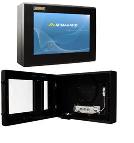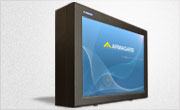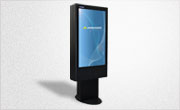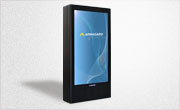The Key Elements of Digital Signage
Posted by: Richard Williams | Posted on: | 0 Comments
On the surface, digital signage seems a simple concept. Modern flat screen LCD screens, placed in out of home locations that play advertising or informational content; however, as with any modern technology, digital signage isn’t as simple as all that and several key elements go into creating a digital signage system. With more and more smaller companies getting involved with digital signage, installing their own screens and generating their own content, understanding these key elements is increasingly important.
Screen—the most fundamental aspect of a digital signage system, the screen is what everything else centres about. Due to their low cost, most digital signage systems use LCD displays, but for some applications, plasma screens are still used. Due to their more rugged capabilities and longer life, commercial grade screens are the most common form of screen used for digital signage. For outdoor digital signage applications, high brightness screens are required to ensure maximum readability in high sunlight. Positioned in either portrait or landscape mode, LCD screens used for digital signage can vary in size from 20” to giant cinema-sized screens.

Digital signage enclosure
Hardware—Apart from the screen, other hardware is essential for a digital signage system, including, mounts, stands and a digital signage enclosure to protect the screen from impacts and vandalism. For standalone systems, media players, which play the content, are also needed, not to mention the myriad of cables and wires that connect everything together.
Content—as fundamental as the screen itself, the content played on a digital signage display is the purpose of the whole exercise. Content is either, generated professionally in the same way as other advertising is produced, or increasingly, users can create their own content. Whatever method of content creation is used, all media needs to be relevant, eye-catching and to the point.
Software—you have the screen, you have hardware and you have the content, but without the appropriate software, you won’t be able to display anything. Software for digital signage has several functions, including streaming the content to the screen and scheduling content to play at certain times. There seems to be an almost unlimited number of software packages designed for content delivery, so choosing the right software for the right system can be extremely difficult.
Content Delivery—For networked systems, content needs to travel from the server to the screen and this may often involve expensive wiring and networking, connecting all the screens to broadband connections.
Installation—finally, when everything is gathered together, the task of connecting everything up and installing the screens also needs considering as a key element of a digital signage system. While a single screen placed on a wall outside may be a simple affair to install, for installations of hundreds or even thousands of screens, it becomes a major logistical challenge.
Post shortlink:
Popular Products
LCD Enclosure
Need armor for your LCD/LED screen(s)? Outdoors or inside the versatile LCD enclosure protects against thieves, vandals & the weather. Installation idea: NFL stadiums.
Outdoor Digital Signage
Exclusive 46” outdoor screen protection. Dubbed the ‘Totem’, due to its distinct design, it repels damage threats, but attracts audiences. Installation idea: Drive-thru restaurants.
Portrait Flat Panel Enclosure
Safeguard your eye-level advertising display screen(s), indoors or outdoors. Completely customizable, add exciting features like touch screen technology. Installation idea: Restaurant frontages.
Indoor Digital Signage
Popular purchase for retail outlets! Great for ‘point of sale’ persuasion, boost your brand with static & motion advertising from a single unit! Installation idea: Mall of America.




